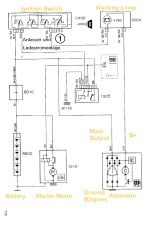Shibbiscus
New member
Hi!
So me and my partner have had our fiat ducato from 1985 for 2 months, learning alot but got som issue with the generator not getting enough signal to start charging.
We have done a lot of searching and fixing to get it right but nothing is working.
Wondering if anyone has access to an electricity diagram for this caravan?
Also wondering if anyone has eny experience or expertise that could help us out by answering on some more complex questions about our situation.
We have tried a testcabel from the battery to DF stift to see that the generator is charging the battery if we give it enough power to starr charging which it did.
So we started looking more at the electricity.
What happened next was we changed two relays in the glove compartment which we guessed might have something to do with it. Didnt change much. We guessed the lamp in the instrumentpanel might have been the issue as the DF cabel only got 6v but when we changed the lamp it got 9.6v. Which helped it start up twice but then didnt work again.
This all started when we tried the fridge for the first time while driving on the car battery. So maybe we ****ed some circuit up while doing that as we are noobs and when the fridge stopped working while driving 4h (it worked at the beginning). We tejped down the fridge button on the fuse box when it stopped working as chat gpt said it should be pressed down. (feel stupid now to have trusted that)..
Last thing we did was run a new cabel outside of the normal circuit, from a fuse that goes on ignition to an external lamp and then to DF on the generator.
But now I think it might have been on the wrong poles of the lamp because after this, the normal DF cable gives 0 energy, before it was 9.6v...
Did we **** up bad?
Did we break something even more?
Please help us

So me and my partner have had our fiat ducato from 1985 for 2 months, learning alot but got som issue with the generator not getting enough signal to start charging.
We have done a lot of searching and fixing to get it right but nothing is working.
Wondering if anyone has access to an electricity diagram for this caravan?
Also wondering if anyone has eny experience or expertise that could help us out by answering on some more complex questions about our situation.
We have tried a testcabel from the battery to DF stift to see that the generator is charging the battery if we give it enough power to starr charging which it did.
So we started looking more at the electricity.
What happened next was we changed two relays in the glove compartment which we guessed might have something to do with it. Didnt change much. We guessed the lamp in the instrumentpanel might have been the issue as the DF cabel only got 6v but when we changed the lamp it got 9.6v. Which helped it start up twice but then didnt work again.
This all started when we tried the fridge for the first time while driving on the car battery. So maybe we ****ed some circuit up while doing that as we are noobs and when the fridge stopped working while driving 4h (it worked at the beginning). We tejped down the fridge button on the fuse box when it stopped working as chat gpt said it should be pressed down. (feel stupid now to have trusted that)..
Last thing we did was run a new cabel outside of the normal circuit, from a fuse that goes on ignition to an external lamp and then to DF on the generator.
But now I think it might have been on the wrong poles of the lamp because after this, the normal DF cable gives 0 energy, before it was 9.6v...
Did we **** up bad?
Did we break something even more?
Please help us
- Model
- Fiat ducato XN1T
- Year
- 1985


